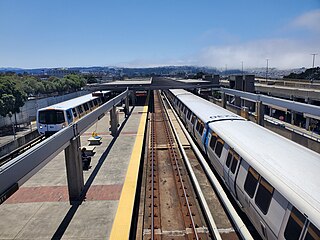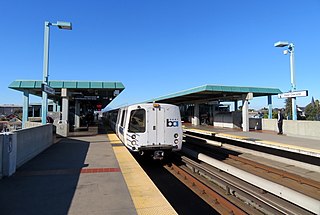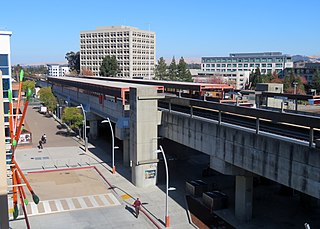
Bay Area Rapid Transit (BART) is a rapid transit system serving the San Francisco Bay Area in California. BART serves 50 stations along six routes and 131 miles of track,including eBART,a 9-mile (14 km) spur line running to Antioch,and Oakland Airport Connector,a 3-mile (4.8 km) automated guideway transit line serving Oakland International Airport. With an average of 169,800 weekday passenger trips as of the third quarter of 2024 and 48,119,400 annual passenger trips in 2023,BART is the sixth-busiest rapid transit system in the United States.

The Transbay Tube is an underwater rail tunnel that carries Bay Area Rapid Transit's four transbay lines under San Francisco Bay between the cities of San Francisco and Oakland in California. The tube is 3.6 miles (5.8 km) long,and attaches to twin bored tunnels. The section of rail between the nearest stations totals 6 miles (10 km) in length. The tube has a maximum depth of 135 feet (41 m) below sea level.

Balboa Park station is a Bay Area Rapid Transit (BART) station and Muni Metro complex in the Mission Terrace neighborhood of San Francisco,California,located near the eponymous Balboa Park. It is an intermodal hub served by four BART routes,three Muni Metro lines,and a number of Muni bus routes. The station complex also includes two rail yards,Cameron Beach Yard and Green Light Rail Center,where Muni maintains Muni Metro trains and heritage streetcars. BART uses a below-grade island platform on the west side of the complex;Muni Metro routes use several smaller side platforms located on surface-level rail loops around the yards.

Daly City station is an elevated Bay Area Rapid Transit (BART) station in Daly City,California,just south of the city limits of San Francisco. It is adjacent to Interstate 280 and California Route 1,which it serves as a park-and-ride station. The station is served by the Red,Yellow,Green,and Blue lines;it is the western terminus of the Green and Blue lines.

West Oakland station is a Bay Area Rapid Transit (BART) station in the West Oakland neighborhood of Oakland,California. It has two elevated side platforms and is located near the eastern end of the Transbay Tube. All main BART lines except the Orange Line stop at the station. The Oakland Wye is located to the east of the station.

Lake Merritt station is an underground Bay Area Rapid Transit (BART) station located east of Downtown Oakland near the eponymous Lake Merritt. The station is served by the Orange,Green,and Blue lines. It is the nearest BART station to Chinatown,Laney College,and Jack London Square station.

Rockridge station is a Bay Area Rapid Transit station located in the Rockridge district of Oakland,California. Located in the center median of the elevated State Route 24 west of the Caldecott Tunnel,the station has a single island platform serving two tracks. It is served by the Yellow Line.

Walnut Creek station is an elevated Bay Area Rapid Transit (BART) station in Walnut Creek,California,served by the Yellow Line. The station is located north of downtown Walnut Creek,adjacent to Interstate 680 and near the Ygnacio Valley Road and California Boulevard arterial roads.

Concord station is a Bay Area Rapid Transit (BART) station in Concord,California. The station is located between the downtown business district to the west and residential neighborhoods to the east. Concord station has a single elevated island platform and is served by the Yellow Line.

Fremont station is a Bay Area Rapid Transit (BART) station in the central district of Fremont,California. The station is served by the Orange and Green lines. It was the southern terminus of both lines from September 11,1972,until March 25,2017,when Warm Springs/South Fremont station opened.

Downtown Berkeley station is an underground Bay Area Rapid Transit (BART) station in the Downtown Berkeley section of Berkeley,California. It is served by the Orange and Red lines.

El Cerrito del Norte station is a Bay Area Rapid Transit (BART) station located on Cutting Boulevard in El Cerrito,California. The station is served by the Orange and Red lines. Located near San Pablo Avenue and Interstate 80,it serves as a regional transit hub for local AC Transit bus services,and for commuter feeder services from Solano,Napa,and Marin Counties in the North Bay plus western Contra Costa County. Opened in 1973,the station was renovated in 2017–2021 to add additional elevators,stairs,and lobby space.
Richard A. White is an American public transportation official who served as the CEO and General Manager of the Washington Metropolitan Area Transit Authority during 1996–2006. Prior to joining WMATA as CEO,he served as the general manager at Bay Area Rapid Transit in the San Francisco area. White also spent six years with the federal Urban Mass Transit Administration,which is now the Federal Transit Administration. White is from Massachusetts.
Throughout the history of Bay Area Rapid Transit,there have been plans to extend service to other areas.
Bay Area Rapid Transit,widely known by the acronym BART,is the main rail transportation system for the San Francisco Bay Area. It was envisioned as early as 1946 but the construction of the original system began in the 1960s.

Berryessa/North San Joséstation is an intermodal transit center located in the Berryessa district of San Jose,California,United States. The station is served by Bay Area Rapid Transit (BART) and Santa Clara Valley Transportation Authority (VTA) buses. The transit center opened for bus service on December 28,2019,and subsequently for BART service on June 13,2020. The station is the southern terminus of the Orange and Green lines.
The Silicon Valley BART extension is an ongoing effort to expand the Green and Orange Line service by Bay Area Rapid Transit (BART) into Santa Clara County via the East Bay from its former terminus at the Fremont station in Alameda County. Planned since at least 1981,the project has seven stations in three sequential phases.
Bill "Billy" Richard Stokes was a mass transportation specialist and advocate most famous for being the General Manager of the San Francisco Bay Area Rapid Transit (BART) District during the initial construction and start of service of BART.

Grace Crunican is a mass transportation specialist who most recently served as general manager of the San Francisco Bay Area Rapid Transit (BART) District. She had previously worked for the Oregon Department of Transportation,the Federal Transit Administration,and the Seattle Department of Transportation,and also at the mass transit lobbying organization called the Surface Transportation Policy Project.
Dorothy W. Dugger is a mass transportation specialist who worked for the San Francisco Bay Area Rapid Transit (BART) district from 1992 to 2011,spending the last four years as BART's first female general manager.













